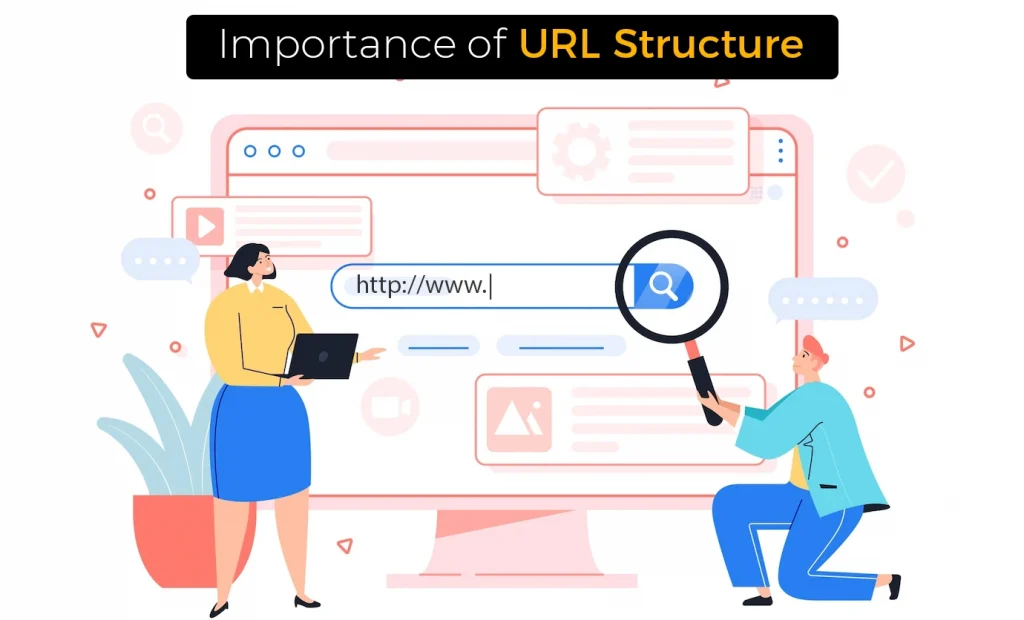Understanding URL Structures: The Foundation of Technical SEO

Introduction
A solid technical SEO strategy is built on a well-URL Structures. URLs (Uniform Resource Locators) serve as the web address for your content, providing critical information to both search engines and users. Beyond mere navigation, URLs influence how search engines crawl, index, and rank your pages, as well as how users perceive your content. This blog explores the components of an ideal URL structure, why it matters for SEO, and actionable tips to create SEO-friendly URL Structures
Why URL Structure is Crucial in Technical SEO
The way your URLs are structured is important for:
1. Crawlability
Search engines employ URLs to locate and crawl content. Search engines can more easily comprehend your site hierarchy and index pages more effectively if your URL structure is clear and logical.
2. User Experience
Well-crafted URLs are easy to read and give users an immediate idea of the content they can expect, leading to better click-through rates (CTR).
3. Keyword Optimization
Including relevant keywords in your URL can signal to search engines what the page is about, boosting its ranking potential.
4. Link Sharing
Clean and concise URLs are more likely to be shared by users, which increases your content’s visibility and backlink potential.
Key Elements of a Strong URL Structure
- Protocol (HTTP or HTTPS): Always use HTTPS for security and trustworthiness. Google prioritizes HTTPS pages in search rankings.
- Domain Name: Choose a concise, brandable domain name that reflects your business or content.
Example: www.example.com - Subdomains and Subdirectories: Use subdirectories (/blog/) rather than subdomains (blog.example.com) for better SEO, as search engines often treat subdomains as separate entities.
- Readable Path: Avoid using unnecessary characters or long numeral sequences.
Bad URL: https://example.com/12345?ref=56789
Good URL: https://example.com/blog/seo-basics - Keywords in the URL: Include primary keywords naturally without stuffing. This makes the text easier for readers and search engines to grasp.
Example: https://example.com/technical-seo/url-structure - Consistency in Format: Stick to lowercase letters, as URLs are case-sensitive. Avoid spaces and special characters; use hyphens (-) instead of underscores (_).
- Short and Descriptive: Shorter URLs are easier to remember and share. Please keep them under 60 characters.
Best Practices for Creating SEO-Friendly URL Structures
1. Organize Hierarchically
Structure your URLs to reflect your website’s hierarchy. For example:
Homepage: https://example.com/
Category: https://example.com/services/
Subcategory: https://example.com/services/seo/
Individual Page: https://example.com/services/seo/technical-seo-guide
2. Avoid Dynamic Parameters
Replace query parameters (?id=123&sort=asc) with descriptive paths (/product/shoes) whenever possible.
3. Canonicalize URLs
Use canonical tags to prevent duplicate content issues and indicate to search engines the preferred version of a page.
4. Remove Unnecessary Words
Eliminate stop words like “and,” “of,” and “the,” unless they are crucial for clarity.
5. Redirect Old URLs Properly
Use 301 redirects for old or broken URLs to pass link equity to the new URL.
6. Optimize for Mobile
Ensure URLs are mobile-friendly, as mobile-first indexing makes them a priority for Google.
7. Test for Crawlability
To find crawl issues and make sure all URLs are reachable, use tools like Screaming Frog or Google Search Console.
Common Mistakes to Avoid
- Overusing Keywords: Keyword stuffing in URLs can harm rankings and look spammy to users.
Example of Bad URL: https://example.com/seo/seo-guide/seo-tools/ - Inconsistent URL Formats: Mixing https:// with http://, or using both www and non-www versions, creates duplicate content issues.
- Ignoring URL Updates: When rebranding or restructuring a website, failing to update old URLs or redirect them can result in lost traffic and rankings.
- Using Non-Descriptive URLs: URLs like https://example.com/page1 provide no information about the content.
Examples of Effective URL Structures
1. E-commerce
Category: https://example.com/shoes/mens/
Product: https://example.com/shoes/mens/running-shoes/
2. Blog
Category: https://example.com/blog/seo/
Post: https://example.com/blog/seo/url-structure-guide/
3. Services
Main Service: https://example.com/services/seo/
Specific Service: https://example.com/services/seo/audit/
Conclusion
In addition to improving user experience, a well-structured URL also makes your website easier to crawl and perform better in search results. By crafting clean, descriptive, and organized URLs, you provide clear signals to search engines and users about the relevance of your content. A thoughtful URL strategy forms the foundation of technical SEO, ensuring your site ranks higher in search results and delivers a seamless experience. As you implement these best practices, remember to audit and update your URLs regularly to keep up with evolving SEO trends.



